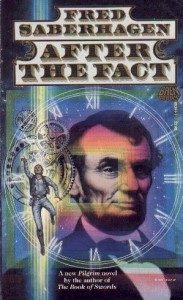Lately it appears to me what a long, strange trip it’s been.
— Robert Hunter of the Grateful Dead
We are all travellers in the wilderness of the world, and the best we can find in our travels is an honest friend.
— Robert Louis Stephenson
I thank my long time friend Jonathan Smith for invaluable encouragement, guidance, and practical assistance.
I thank the anonymous reviewer who pointed out that I was using time used in multiple senses in an
earlier work.
I thank Ferne Cohen Welch for extraordinary moral and practical support.
I thank Linda Marie Kalb and Diane Dugan for their long and ongoing moral and practical support.
I thank my brothers Graham and Gaylord Ashmead and my brother-in-law Steve Robinson for continued encouragement.
I thank Oz Fontecchio, Bruce Bloom, Shelley Handin, and Lee and Diane Weinstein for listening to a perhaps baroque take on free will and determinism. I thank Arthur Tansky for many helpful conversations and some proofreading. I thank Chris Kalb for suggesting the title.
I thank John Cramer, Robert Forward, and Catherine Asaro for helpful conversations (and for writing some fine SF novels). I thank Connie Willis for several entertaining conversations about wormhole physics, closed causal loops and the like (and also for writing several fine SF stories).
I thank Stewart Personick for many constructive discussions. I thank Matt Riesen for suggesting the use of Rydberg atoms. I thank Terry the Physicist for useful thoughts on tunneling and for generally hammering the ideas here. I thank Andy Love for some useful experimental suggestions, especially the frame mixing idea. I thank Dave Kratz for helpful conversations. I thank Paul Nahin for some useful email. I thank Jay Wile for some necessary sarcasm.
I thank John Myers and others at QUIST and DARPA for useful conversations.I thank the participants at the third Feynman festival for many good discussions, including Gary Bowson, Fred Herz, Y. S. Kim, Marilyn Noz, A. Vourdas, and others. I thank Howard Brandt for his suggestion of internal decoherence.
I thank the participants at The Clock and The Quantum Conference at the Perimeter Institute for many good discussions, including J. Barbour, L. Vaidman, R. Tumulka, S. Weinstein, J. Vaccaro, R. Penrose, H. Price, and L. Smolin.
I thank the participants at the Third International Conference on the Nature and Ontology of Spacetime for many good discussions, including V. Petkov, W. Unruh, J. Ferret, H. Brown, and O. Maroney.
I thank the participants at the fourth Feynman festival for many good discussions, including N. Gisin, J. Peřina, Y. S. Kim, L. Skála, A. Vourdas, A. Khrennikov, A Zeilinger, J. H. Samson, and H. Yadsan-Appleby.
I thank the librarians of Bryn Mawr College, Haverford College, and the University of Pennsylvania for their unflagging helpfulness. I thank Mark West and Ashleigh Thomas for help getting set up at the University of Pennsylvania.
I thank countless other friends and acquaintances, not otherwise acknowledged, for listening to and often contributing to the ideas here.
I acknowledge a considerable intellectual debt to Yakir Aharonov, Julian Barbour, Paul Nahin, Huw Price, L. S. Schulman, Victor J. Stenger, and Dieter Zeh.
I thank Balticon for having me speak on this. And I thank Chris Heimark and the other members of my Macintosh Programming SIG for inviting a talk on quantum time.
Finally, I thank the six German students at the Cafe Destiny in Olomouc who over a round of excellent Czech beer helped push this to its final form.
And of course, none of the above are in any way responsible for any errors of commission or omission in this work.
